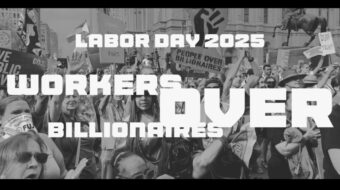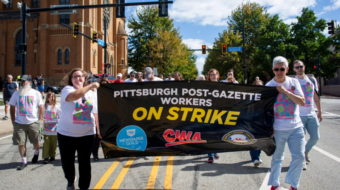Original source:
The Lilly Ledbetter Fair Pay Act justly received a lot of media attention in January, briefly refocusing our national attention on the gender discrepancies that still haunt our workplaces. But now that the issue has faded from the national conciseness, women are still paid less than their male counterparts (just 78 cents to the dollar). Women are disproportionately represented in low-paying jobs. Two-thirds of minimum wage workers and approximately 90 percent jobholders that earn $15,000 a year are women, according to labor studies professor Dorothy Cobble.
Unions are essential to redressing these disparities, particularly for those working low-paid jobs and supporting families. Unionization assuages one of the most flagrant inequalities between the sexes, unequal pay. According to a report by the Center for Economic and Policy Research (CEPR), unionized women earn $2 more per hour than their non-affiliated counterparts. And in low-wage occupations, the benefits are even greater: “In the 15 lowest-paying occupations, union members earned 14 percent more than those workers who were not in unions,” the study said. For these women, unionization and the benefits it brings can make a big difference.
‘For women, joining a union makes as much sense as going to college,’ said the study’s author, John Schmitt, in a press release. ‘All else equal, joining a union raises a woman’s wage as much as a full-year of college, and a union raises the chances a woman has health insurance by more than earning a four-year college degree.’
Health insurance is just one of the benefits unions can provide for working women. One job benefit the CEPR study didn’t take into account was family and sick leave. Many women are still expected to shoulder an unequal burden in terms of home, family, and child care, but cannot afford to take time off from work to care for a sickly child or look after an ailing relative. Sometimes, these women must choose between the health of their family and paying the rent.
In the AFL-CIO’s 2006 “Ask A Working Woman Survey”, a staggering two-thirds of women reported a complete lack of family leave benefits. The 2008 survey found that because the burden of family care falls disproportionately on women, those workers who were lucky enough to have paid sick leave would often use their time to care for family members rather than themselves. Nearly 76 percent of low income workers have no paid sick leave and don’t even have that option.
Karen Naussbaum, the founder and director of 9to5, the National Association of Working Women, pointed out in the Boston Review thatunions provided workers with benefits like job-guaranteed parental leave years before the federal government passed the (inadequate) 1993 Family Medical Leave Act. In the late 1990s, unionized workers were still 20 percent more likely to have paid time off to care for sick children than their non-union counterparts, and in 2002, unions were essential in pushing through California state laws guaranteeing paid family and medical leave (similar laws have prevailed in New Jersey, and Washington state, thanks in part to union backing).
Of course, unions aren’t a silver bullet for gender inequalities in the workplace. At best, they are improving the lot of women workers that are unfairly disadvantaged, but they are doing little to confront systemic inequalities, which, to be fair, are a lot harder to change. “The fundamental fact of employment and gender is that we are a long way from having an integrated workforce and that comes with all sorts of other baggage too, like unequal pay,” said Ruth Milkman, sociologist and director of UCLA Institute of Industrial Relations. “A lot of the gender gap in pay that persists is due to gender segregation. People think of it as unchangeable. There is plenty of outright, plain old garden variety discrimination, but more often women and men are doing different jobs and the women’s jobs just happen to be paid a lot less then the men’s jobs.”
The decline of manufacturing n the United States has contributed to pay gaps too. “As the better paying jobs have dried up or gone over seas we were left increasingly with the service or retail jobs that are historically low-paid and tend to be more for women then men,” said Barbara Ehrenreich, author of Nickel and Dimed, an exploration of the strenuous world of “unskilled” labor. “Women are much more likely then men to have responsibilities for children, so that means an extra burden. It is a structurally bad situation.” These jobs are overwhelmingly non-unionized due to the impunity with which employers illegally fire and intimidate easily replaceable (from the managerial perspective) service sector employees. The hotly contested Employee Free Choice Act would increase fines against such unscrupulous employers.
Fifty-five percent of all new workers organized are women, but this is largely attributable to the expanding job market in the service sector and social services, rather than an outburst of female enthusiasm for unions. Women have actually had less positive views about unions in recent years, although some studies show that most workers would still join one if they could.
There are several factors at work behind these numbers. For one thing, institutional union leadership is still dominated by men. A recent AFL-CIO study scolded some unnamed unions for lacking a commitment to increase female membership, warning that “women think of unions as being made up largely of men” and that “the reference to ‘labor unions’ means blue-collar workers exclusively.”
“The anachronistic [hyper-masculine] image of unions is still alive because the strength of organized labor has declined so much in recent years,” Milkman said. “Women get a ticket to ride after the gravy train has already left the station. The feminization and increased female union membership has come at a time when unions in general have weakened a lot. That the male macho iconography still survives even though it is rooted in another period a reflection of that.”
Unions have been weakening in recent years, but increased organizing, particularly of women, could reverse those trends. Women workers could reverse trends of denied benefits and advocate for a living wage if they were willing to unionize. The labor movement could use the membership; if the movement wants to revive itself and win the trust of non-unionized female workers they need to focus on tangible outcomes. EFCA could help build the American labor movement, but they also need to focus on issues like paid maternity leave, paid family leave, and pay equity. While this wouldn’t automatically close the pay gap or integrate our gender-divided economy, it would at least dampen the detrimental effects of pay inequalities.
Jake Blumgart is an editorial intern at Campus Progress.









